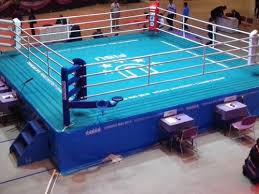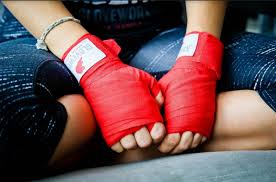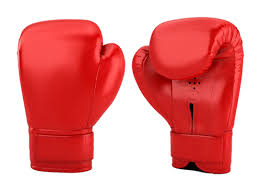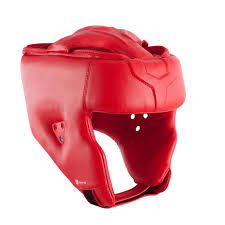
About Boxing
Boxing is a combat sport played between two players where one player tries to win by, hitting the other player hard, within the stipulated area.
This is one of the oldest sports played by mankind, dating back to 1350 BC. With time, more rules were introduced into boxing to protect the players and to make the sport attractive and fast.
Boxing is divided broadly into two categories Amateur and Professional boxing. Professional boxers have much more stamina and proven attacking and winning abilities with regards to amateur boxers.
Professional boxing is a slow-paced boxing fight often going to twelve rounds of three minutes each with a minute break between each round. These fights are organized by the promoters of the boxers and involve large sum as prize money.
In professional boxing, things are very different, three judges decide the points earned using a ten-point system to determine the winner of each round. The fighter with the most points at the end of the bout is the winner.
Amateur boxing is a much fast-paced boxing match where the focus is more on the attack. They are played in 3 round each of two minutes duration with a minute break between each round.
The amateur boxers that take part in different boxing tournaments across the world like Olympics, Nationals and Commonwealth games. Professional boxers are not allowed to compete in these events.
The International Boxing Association (AIBA) is the governing body that organizes different world boxing tournaments formulates changes in rules and appoints judges.
Boxing Olympic 2020 logo : ![]()
History
Boxing is one of the oldest sports and has recorded history dating back to 1350 BC. It gained popularity with Greeks, and they have introduced this sport in ancient Olympics dating back to 688 BC. In 16th-century fist fighting became a popular sport among Englishman.
Early boxing did not have any rules, only rule was to hitting the opponent hard to thwart the opponent. With the increase in death of boxers, an English boxing champion Jack Broughton wrote the rules, of this sport to protect boxers.
Hitting below the waist was prohibited, and if a boxer could not rise, after a count of 30 seconds the fight was declared as over.
The introduction of Marquess of Queensberry rules drafted by John Chambers in 1867, divided the sport into Lightweight, Middleweight and Heavyweight with the introduction of the gloves also changed the nature of boxing.
Boxing gained popularity, and the introduction of more stringent rules protected the players and made the game fast.
Men’s boxing was introduced in Olympics in the year 1904 and has always been part of the Olympics since then except in the 1912 Stockholm Olympics as Swedish law banned this sport. In 2012, women’s boxing was introduced, as a part of the London Olympics.
Objective
The objective of the sport is to throw punches at the opponent, thus attacking and defend the punches, from the opponent known as defending within the stipulated time allocated for the match.
The players are awarded points for landing a proper punch within the stipulated area of the opponent’s body during the playing time.
The player can also win the bout by a knockout, where the player knocks out his opponent and the opponent is not able to stand up after the count of 10 seconds.
So, the objective of the game is to punch the opponent and acquire points or win by knockout or by technical knockout.
Equipments
The equipment required for boxing is the boxing ring, Gloves and other safety measures for the players.
Boxing Ring: The boxing match is organized, in a square court known as a boxing ring. The court is surrounded by four thick padded ropes, on all sides. There are four corners of the court, two of them are player’s corners, and two are neutral corners.
The boxing ring is raised from the ground, by around 5 feet, and the ring varies from, 18-24 ft on each side with 2 ft extending outside the ropes. Poles supporting the ropes are attached to each of the corners.
Hand Bandages: Players are allowed to wear hand bandages that are used to protect the hand and knuckles. Hand bandage should not exceed 10.9 meters per hand. The bandage is made up of soft gauge material two inches wide.
The gauge can be held in its place by the adhesive tape of one and a half inches thick. It should be made sure that the adhesive tape should not cover any part of the knuckles of the fist with a clenched hand.
Gloves: Players are allowed to wear gloves to protect their hands and knuckles. They provide cushion for the hand and also protects the opponent from getting hurt through the knucklebones. The boxing gloves weigh about 8 ounces for Strawweight to Welterweight and weighs 10 ounces for Superwelterweight to Heavyweight. Mouth Guard: Mouthguard is used by the boxers to protect their teeth during the match. This guard is compulsory for each boxer. During the match, if the mouthguard of any players dislodges, the referee immediately stops play, by calling time to allow the player to wear back the mouth guard.
Mouth Guard: Mouthguard is used by the boxers to protect their teeth during the match. This guard is compulsory for each boxer. During the match, if the mouthguard of any players dislodges, the referee immediately stops play, by calling time to allow the player to wear back the mouth guard.
Head Guard: Boxing is a combat sport, a hard hit on the head could be life-threatening. It is mandatory to wear headgear in Amateur Boxing; this guard is composed, of soft cushion material that is tied on the head of a player with ropes to protect player’s head ears from injuries. Boxing Shoes: The floor of the boxing ring is polished; players are allowed to wear anti-skid boxing shoes. These shoes are flat, without soles and allow, player’s feet to move around in the court comfortably.
Boxing Shoes: The floor of the boxing ring is polished; players are allowed to wear anti-skid boxing shoes. These shoes are flat, without soles and allow, player’s feet to move around in the court comfortably. Dress: Boxers wears shorts that are knee height and are loose and comfortable that does not hinder their fast-paced movement. They also wear a loose vest to cover their upper torso.
Dress: Boxers wears shorts that are knee height and are loose and comfortable that does not hinder their fast-paced movement. They also wear a loose vest to cover their upper torso.
Boxing Categories
Boxing is divided, into different categories based on the weights of the players. It is mandatory in boxing to play a match with the opponent that belongs to the same weight category.
Weight classification of the players is done, during the official weigh-in of the player. It does not depend upon the weight of the boxers at the time of the contest.
Match Officials
Boxing being a fast pace combat sport with quick scoring points, hence it is officiated by a team of match officials that have different tasks assigned to them.
Referee: The referee is the sole in-charge of the boxing match. The referee is the person that can stop the contest at any stage if the contest is one-sided or the player would not be able to continue due to injury.
Referee identifies the second chief of each player and holds them responsible for the conduct of their respective corners. It is the responsibility of the referee to make sure that the contesting players are with proper protective gears.
They check the gloves, bandages, mouth guard of each player and make sure that they are free of extraneous substances that could harm the opponent. Referees decide about the injuries to the player, whether the player can continue or medical attention is required.
Judges: Three judges officiates a match scoring and evaluating points. Individual judge keeps scores of both the players. After completion of each round, the scorecards from each judge is picked and tallied.
The judges make effort, to pick a winner in each round and are not allowed to keep a running score of points. In case, the match is stopped in a round and determined by the scorecard, the judges will score for the round in which the match was stopped.
A 10 point system is used by the judges to score the contest. The points awarded by the judges decide the outcome of a match unless the boxer is knocked out.
Timekeeper: Timekeeper is the official used to keep the time of the rounds; this official is also responsible for assisting the referee in a clear loud voice the time of 10 seconds in case of a knockout.
Timekeeper also rings a bell signalling the finish of the round. The referee has the power to ignore the timekeeper, and that becomes the official ruling.
When the referee calls time, the timekeeper should stop the stopwatch and re-start the stopwatch only when referee orders so.
Ringside Physician: Boxing is a combat sport, a ringside physician is mandatory to be present in case of any injury to the boxer. The physician may enter the ring with the permission of the referee to check the condition of the boxer.
The physician can also advise the referee between the rounds about the condition of the boxer.
Terms Associated
Boxing Ring: The boxing court or the boxing arena where the players are boxing.
Bout: The match or the contest between two boxers.
Knock-Out: This term is used when a boxer is down, due to a legal blow as determined by the referee. If any part of the player body is on the floor or hanging over the ropes helplessly or a boxer is not able to stand upright is considered as a knock-Out.
Mandatory 8 seconds countdown starts immediately. The player must stand in his feet within those 8 seconds. On the call of 10, the boxer is still down then referee waves both the hands indicating the boxer, has been knocked out.
Technical Knock-Out: If a boxer sustains a severe injury or the boxer is unwilling to continue or the boxer has sustained three knock-out counts.
Jab: A quick straight punch thrown by a boxer to its opponent with his lead hand from a guarding position.
Upper Cut: A rising punch thrown vertically with the rear hand from a guard position.
Hook: A punch delivered in a semi-circular motion by the lead hand, landing in the side of the opponent’s head.
Cross: A powerful straight punch thrown by the rear hand from a guarding position.
Duck: The boxer drops down so that the punch missed the boxer entirely
Slip: Rotating the head or body so that the punch misses the head.
Weave: The boxer moves the head beneath the incoming punch.
Clinch: This is a position where the two boxers are close enough to land punches on each other, thus holding up the other boxer. The referee un-clinches the boxers and both the boxers must take a step back before attacking.
Rules Of Boxing
- The game begins when the referee orders boxers to box.
- An amateur boxing consists of three rounds with a minute of interval between each round.
- Anti-doping of players are mandatory, players can be provided with approved electrolyte drinks and water during the break. Any player found taking banned substances would be disqualified.
- A boxer cannot hit the opponent below the waistline. When hit by a low blow, boxer can be provided five minutes to recover.
- A boxer receives a 20 sec countdown when the boxer is knocked out of the ring to the base floor. The boxer should stand unassisted and return to the boxing ring to continue the bout within those 20 sec.
- Boxer cannot be saved by the bell during the knockout. The referee continues his count even if the round is finished.
- Each boxer is allowed to compete against the boxer belonging to the same weight category.
- A boxer cannot sustain more than three knockouts counts in a match.
- When a boxer is knocked out, the referee orders the boxer to go towards a neutral corner farthest from the opponent. If the boxer fails to stay in the corner, the referee stops the coundown and orders the other boxer, to go to a neutral corner before continuing the count.
- The referee should audibly communicate count to the knocked out boxer.
- If an intentional foul by an opponent causes severe injury to a boxer, may lead to disqualification of the opponent.
- If an intentional foul by an opponent causes injury to a boxer, and the match continues, the referee notifies the judges to deduct two points from the opponent responsible for the injury.
- If a referee decides that the boxer, has conducted in an un-sportsmanlike manner, the referee can stop the match and disqualify the boxer.
- During the interval between the rounds, only one assist of the player is allowed to enter the ring.
World Rankings - Amateur Mens
- World ranking based on categories :
- Flyweight
- Amit

- Shakhobidin Zoirov

- Daniel Asenov

- Featherweight
- Mirazizbek Mirzakhalilov

- Kurt Walker

- Peter McGrail

- Lightweight
- Andy Gomez

- Hovhannes Bachkov

- Keyshawn Davis

- Welterweight
- Pat Mccormack

- Roniel Sotolongo

- Andrei Zamkovoi

- Middleweight
- Gleb Bakshi

- Arlen Cortona

- Tursynbay Kulakhmet

- Lightheavyweight
- Julio Peraza

- Bekzad Nurdauletov

- Benjamin Whittaker

- Heavyweight
- Muslim Gadzhimagomedov

- Julio Torres

- Erislandy Cotilla

- Superheavyweight
- Bakhodir Jalolov

- Kamshybek Kunkabayev

- Richard Torrez

World Rankings - Amateur Womens
- World ranking based on categories :
- Flyweight
- Chol Pang

- Busenaz Cakiroglu

- Mery Kom

- Featherweight
- Yu Lin

- Nesthy Petecio

- Ornella Wahner

- Lightweight
- Beatriz Soares

- Mira Potokonen

- Kellie Harrington

- Welterweight
- Busenaz Surmeneli

- Nien Chen

- Lovlina Borgohain





 (2 votes, average: 5.00 out of 5)
(2 votes, average: 5.00 out of 5)


